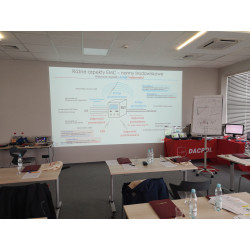Musíte být přihlášen
-
WróćX
-
Komponenty
-
-
Category
-
Polovodiče
- LED diody
- Tyristory
- Elektroizolační moduly
- Přemosťovací usměrňovače
-
Tranzistory
- Tranzistory | GeneSiC
- SiC MOSFET moduly | Mitsubishi
- SiC MOSFET moduly | STARPOWER
- Moduly ABB SiC MOSFET
- Moduly IGBT | MITSUBISHI
- Tranzistorové moduly | MITSUBISHI
- Moduly MOSFET | MITSUBISHI
- Tranzistorové moduly | ABB
- Moduly IGBT | POWEREX
- Moduly IGBT | INFINEON (EUPEC)
- Polovodičové prvky z karbidu křemíku (SiC)
- Przejdź do podkategorii
- Ovladače brány
- Bloky napájení
- Przejdź do podkategorii
- Měniče proudu a napětí LEM
-
Pasivní součásti (kondenzátory, rezistory, pojistky, filtry)
- Rezistory
-
Pojistky
- Miniaturní pojistky pro elektronické obvody řady ABC a AGC
- Trubkové rychle působící pojistky
- Pojistkové vložky s časovým zpožděním s charakteristikami GL / GG a AM
- Ultrarychlé pojistkové články
- Rychle působící pojistky (britský a americký standard)
- Rychle působící pojistky (evropský standard)
- Pojistky pojezdu
- Pojistkové vložky vysokého napětí
- Przejdź do podkategorii
-
Kondenzátory
- Motorové kondenzátory
- Elektrolytické kondenzátory
- Filmové kondenzátory
- Výkonové kondenzátory
- Kondenzátory pro stejnosměrné obvody
- Kondenzátory korekce účiníku
- Vysokonapěťové kondenzátory
- Indukční topné kondenzátory
- Kondenzátory pulsu a energie
- DC LINK kondenzátory
- Kondenzátory pro AC / DC obvody
- Przejdź do podkategorii
- EMI filtry
- Superkondenzátory
- Přepěťová ochrana
- Filtry pro odhalování emisí TEMPEST
- Svodič přepětí
- Przejdź do podkategorii
-
Relé a stykače
- Teorie relé a stykačů
- 3fázová střídavá polovodičová relé
- 3fázová střídavá polovodičová relé
- Regulátory, ovládací prvky a příslušenství
- Měkké spouštění a reverzační stykače
- Elektromechanická relé
- Stykače
- Otočné spínače
-
Jednofázová střídavá polovodičová relé
- Jednofázová střídavá polovodičová relé, 1 řada | D2425 | D2450
- Jednofázová střídavá polovodičová relé řady CWA a CWD
- Jednofázová střídavá polovodičová relé řady CMRA a CMRD
- Jednofázová střídavá polovodičová relé řady PS
- Dvojitá a čtyřnásobná střídavá polovodičová relé řady D24 D, TD24 Q, H12D48 D.
- Jednofázová polovodičová relé řady GN
- Jednofázová střídavá polovodičová relé řady CKR
- Jednofázová AC relé na lištu DIN řady ERDA A ERAA
- Jednofázová AC relé pro proud 150 A.
- Dvojitá polovodičová relé integrovaná s chladičem pro lištu DIN
- Przejdź do podkategorii
- Jednofázová AC polovodičová relé pro PCB
- Relé rozhraní
- Przejdź do podkategorii
- Jádra a další indukční součásti
- Radiátory, varistory, tepelné ochrany
- Fanoušci
- Klimatizace, příslušenství pro elektrické skříně, chladiče
-
Baterie, nabíječky, vyrovnávací zdroje a střídače
- Baterie, nabíječky - teoretický popis
- Lithium-iontové baterie. Vlastní baterie. Systém správy baterií (BMS)
- Baterie
- Nabíječky baterií a příslušenství
- Záložní zdroj UPS a vyrovnávací napájecí zdroje
- Převaděče a příslušenství pro fotovoltaiku
- Úschovna energie
- Palivové články
- Lithium-iontové baterie
- Przejdź do podkategorii
- Automatika
-
Kabely, dráty, vodiče, flexibilní připojení
- dráty
- Kabelové průchodky a spojky
- lanka
- Kabely pro speciální aplikace
- košile
-
prýmky
- prýmky byt
- prýmky kolo
- Velmi flexibilní opletení - plochý
- Velmi flexibilní opletení - Round
- Měď opletené válcové
- Mědí štít a válcové
- Flexibilní zemnící pásky
- Opletení válcovité pozinkované a nerezové oceli
- PVC izolované měděné pletivo - teplota 85 ° C
- Ploché pletené hliníkové
- Connection Kit - prýmky a trubky
- Przejdź do podkategorii
- Příslušenství pro trakční
- kabelové botky
- Ohebné izolované přípojnice
- Vícevrstvá ohebná lišta
- Systémy vedení kabelů
- Przejdź do podkategorii
- Zobacz wszystkie kategorie
-
Polovodiče
-
-
- Suppliers
-
Applications
- AC a DC pohony (střídače)
- Automatizace HVAC
- CNC obráběcí stroje
- Energy bank
- Indukční ohřev
- Komponenty pro prostředí s nebezpečím výbuchu (EX)
- Měření a regulace teploty
- Měření a regulace teploty
- Motory a transformátory
- Napájecí zdroje (UPS) a usměrňovací systémy
- Průmyslová automatizace
- Průmyslová automatizace
- Průmyslová ochranná zařízení
- Stroje na sušení a zpracování dřeva
- Stroje na tvarování plastů za tepla
- Svařovací stroje a svářecí stroje
- Těžba, hutnictví a slévárenství
- Tisk
- Tramvajová a železniční trakce
- Zařízení pro distribuční, řídicí a telekomunikační skříně
-
Instalace
-
-
Induktory
-
-
Indukční zařízení
-
-
Servis
-
- Kontakt
- Zobacz wszystkie kategorie
Basics of Electromagnetic Compatibility: What It Is and Why It's Important? 1 of 8

Basics of Electromagnetic Compatibility: What It Is and Why It's Important? 1 of 8
Definition of Electromagnetic Compatibility (EMC)
Electromagnetic Compatibility (EMC) is a field of science and engineering that deals with preventing electromagnetic interference and ensuring that electronic devices and systems can operate alongside each other without mutual electromagnetic interference. In short, EMC concerns the ability of devices to function in environments with various sources of electromagnetic disturbances and minimize their impact on other devices.
In today's world, where electronics and communication systems are widely used in various fields such as industry, transportation, medicine, and telecommunications, issues related to EMC are of immense importance. Without proper electromagnetic compatibility, there is a risk of disturbances that can lead to system failures, data loss, and even pose a threat to user safety.
Within the field of Electromagnetic Compatibility, there are standards and regulations that define the minimum requirements for electromagnetic emissions and immunities. Organizations such as the International Electrotechnical Commission (IEC) and the Federal Communications Commission (FCC) develop standards that must be followed to meet EMC requirements. Compliance with these standards allows for effective cooperation between different electronic devices and minimizes the risk of electromagnetic interference.
It is important for manufacturers, designers, and engineers to have an awareness and understanding of Electromagnetic Compatibility and to implement appropriate techniques for designing, testing, and securing devices to ensure their reliability, durability, and compliance with regulations. Through proper EMC practices, the risk of electromagnetic interference can be minimized, thereby ensuring stable and safe operation of electronics in various environments.
Basic Principles of Electromagnetic Compatibility (EMC):
Electromagnetic Compatibility (EMC) is based on several key principles aimed at minimizing electromagnetic interference and ensuring the uninterrupted operation of electronic devices and systems. Here are the basic principles of EMC:

Principle of Emission
This principle concerns controlling the electromagnetic interference emissions generated by devices. Electronic devices can produce various types of electromagnetic signals that can interfere with the operation of other devices. The task of EMC is to limit these emissions by employing appropriate design techniques, shielding, filtering, and other measures to minimize the generation of electromagnetic disturbances.

Principle of Immunity
This principle pertains to the resistance of devices to electromagnetic disturbances originating from other sources. Electronic devices should be resilient to electromagnetic disturbances that may occur in the environment, such as radio signals, electromagnetic fields, or electrical surges. Through proper design, shielding, attenuation, and other techniques, devices can be more resistant to disturbances and maintain their operational integrity.

Principle of Separation
This principle concerns ensuring adequate separation between devices to avoid mutual electromagnetic interference. Devices should be designed and placed in such a way as to minimize interaction between them. Examples of actions consistent with this principle include proper cable and wire arrangement, use of screens and shields, and appropriate spatial planning of electronic systems.
Principle of Control
This principle involves monitoring and controlling the quality of signals and voltages in electronic devices. By monitoring and regulating electrical signals and eliminating unwanted interference, the quality and stability of device operation can be effectively controlled.
Understanding and applying these basic principles of EMC is crucial for designers, engineers, and manufacturers of electronic devices. By adhering to these principles, the risk of electromagnetic interference can be minimized, ensuring reliability, durability, and compliance with regulatory requirements for electronic devices.
The Essence and Significance of Electromagnetic Compatibility (EMC) in Today's Technological Environments:
In today's digital world, where electronic devices and communication systems are an integral part of our lives, the essence of Electromagnetic Compatibility (EMC) is becoming increasingly important. EMC is crucial for ensuring the uninterrupted operation of devices and systems in the presence of diverse sources of electromagnetic disturbances.
The main objective of EMC is to minimize electromagnetic interference, which can cause failures, malfunctions, data loss, or even risk to user safety. The introduction of electromagnetic disturbances can lead to communication interference, instability in device operation, transmission errors, and contribute to performance limitations and improper functioning of electronic control systems.
It is important to understand that in today's technological environments, there are many different sources of electromagnetic disturbances. This may include radio transmissions, telecommunication systems, power grids, electric motors, medical devices, and even everyday consumer electronics. The impact of these disturbances on the operation of other devices can be significant and lead to serious consequences.
Therefore, the significance of EMC cannot be underestimated. Compliance with EMC principles and standards is not only a legal requirement in certain industries but also a necessary condition for ensuring the reliability, durability, and safety of electronic devices. EMC practices allow for the identification, control, and minimization of both electromagnetic emission and immunity disturbances, as well as the appropriate design, testing, and protection of electronic systems.
In the present times, when technology and electronics are integral parts of our professional and personal lives, proper EMC management is incredibly important. It contributes to ensuring the reliability of our devices, minimizing the risk of failures, protecting the health and safety of users, and facilitating stable and efficient operation in diverse environments.
Související produkt
Související příspěvky
 Now available – DC/DC converters from PREMIUM
Now available – DC/DC converters from PREMIUM
 New release in DACPOL lighting for lathes – Kira covers
New release in DACPOL lighting for lathes – Kira covers





Zanechat komentář